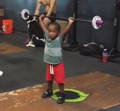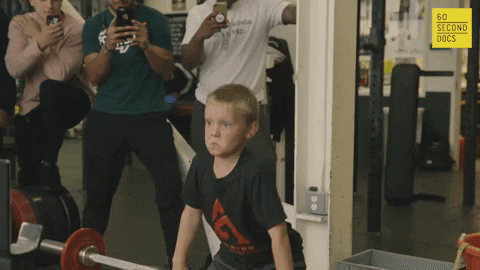Does Weight Training Stunt Growth?!?
FREE SPEED & POWER WORKOUT!
Download by entering below

Does Weight Training Stunt Growth?!?
The common thought is that lifting stunts growth in youth athletes, especially prepubescent athletes. Talking about females prior to the age of 11 or 12 and males 12 or 13 years old. The common thought is that athletes who start to weight train or resistance train prior to that age will have their growth stunted. It’s a pretty thought we hear from parents who bring their kids into the gym. They’re concerned there will be a hindrance to their growth.
I decided to go over a study by Katherine De Haab about strength training in children and adolescents and another meta-analysis by Allison Myers for children and adolescents out of Western Michigan University. I wanted to understand as a father with four children, and two boys who are currently 10 and 6.

As I began, I wanted to first figure out where the concept of growth being stunted stems from. Medicine people referred to the salter harris epiphyseal growth plate fracture. In theory, this growth plate fracture could hinder the growth plate from opening up and hindering the growth in the limb. The theory is that being under load can create a growth plate fracture. Parents have also come in and said that being under the load will compress the individuals and make the kid shorter.
Finally, I think a lot of this comes from the national electronic injury surveillance system that I believe is created by the NIH in the ’70s and ’80s to monitor injuries of prepubescent individuals. What they reported around strength training and resistance training circled around two deaths. The two individuals sadly passed away. Both occurred during a bench press. The reporting of this information globally led to fear around resistance-based strength training.
Myers Points Out
Youth athletes, prepubescent athletes who squat or bench press with athletes or land and jump, we see them bench all over the place, their knees shake, or their knees buckle. That is 100% related to coordination. It is the same reason why when you watch youth athletes perform a sport they are much slower, less coordinated, and are much more hesitant. Some of the injuries that occur in other sports come from the lack of ability to execute a stretch-shortening cycle, which is a very rapid contraction. Youth athletes lacking the coordination, skill, and ability to co-contract sometimes lead to injuries.

Myers’s research shows that in resistance-based training there are .035 injuries per 100 hours. The number for a sport like rugby, football, or soccer injury rate is .8 injuries per 100 hours. That is substantially more rates of injury. From a peer-reviewed journal meta-analysis, there are way fewer injuries during resistance-based training. So if there are only .035 injuries per 100 hours, the likelihood of a stress factor is very minimal, while in other sports the risk is much higher. The risk favors resistance-based training.
What Does Proper Resistance Based Training Provide Youth Athletes?
If we look at having healthy habits, and what Myers’s meta-analysis finds, is that individuals who were prepubescent tended to have greater levels of self-esteem and self-image because they were confident in what they had done in the weight room. They also found that these individuals who strength trained over 6 months developed healthier habits long-term that transferred to the remainder of their life. Kids learn healthy habits around nutrition and exercise. The study also saw that the kids became more coordinated, learned how to co-contract around joints that become unstable, and actually end up having a much lower level of an injury rate. Kids who lift enhance their performance in sports performance, which led to an even greater increase in self-esteem.
Myers’s study also harped on overweight individuals at a young age who benefitted from resistance-based exercises. The young, overweight children did much better with resistance-based exercises verse cardio-based exercises because they felt more confident in the exercises and didn’t feel like constant failures. Naturally, this helped build self-esteem in these kids.
Risks
A very large population of individuals who partake in strength training tend to have lumbar injuries (lower back injuries). Myers’s study notes high rates of lumbar spine pain being reported. The knee-jerk reaction is to not train because the kids will hurt their lower back at some point. The sad part is that almost everyone has lower back pain at some point. We have kids in schools sitting all day so their hamstrings shorten and their glutes turn off. And we’re going to tell them to not strength train? Resistance training can actually improve the functionality of the trunk!

Alright, one of the risks is lower back issues can arise. So we have to be aware of that. We have to warm them up properly, teach proper techniques, and if we do a good job of that, we see a massive decrease in the risk of having a lumbar injury. Resistance-based training for youth athletes (and all athletes) comes down to teaching and educating techniques, proper movement patterns, and giving more instruction from the coaches. Again, science says this.
Morphological Adaptations
As kids start to become more coordinated from strength training and going through motor-skill acquisition periods, their fascicle length lengthens, they can put out more power, and over time their muscles start to grow, their joint capsules become more stable. This creates an improvement in tendon stiffness and an improvement in bone content related to resistance-based training. So, the muscles get bigger, the motor skill acquisition improves, and we see bone density improving. That’s huge.

Resistance-based regiments demonstrate a decreased rate of fracture, muscular tenderness, and muscular injuries when playing sports. So Myers’s study found that kids who take on resistance-based training at a younger age have a decreased rate of fractures, and because of being more coordinated, there is a drastic drop off in traumatic injuries! Again, science says so.
Application
We know there is a risk in training youth athletes to injuries occurring. We also know that in Myers’s study that kids could still be pushed to 1 rep maxes in certain lifts and not get injured (these youth athletes were also better trained).
What I am saying, is that as we have kids come into the gym or kids who have been more sedentary, should not shy away from resistance-based training. But before we start training them, we have to think, “Are they doing other sports that are putting them at a greater risk for injury?” The answer is almost always going to be yes.
The second thing is we have to really spend time with these kids as coaches to coach them up on their movement patterns and our expectations. We also need to coach them up on nutrition. We also need to stress the improvement in overall health, bone density, and less likelihood of injury in other sports that occurs from weight training.
Recap
Moving forward: technique is imperative, positive imperative is important, and weightlifting DOES NOT STUNT GROWTH. Actually, weightlifting, based on research, does the opposite; it improves bone density and joint integrity. There is some discussion that the increase in growth hormone from lifting weights might even stimulate some growth–which is more anecdotal, but where is our scientist out there to study this?
The fact of the matter comes back to improvement of overall health, improvement of the execution of the movement, and recognizing there is a risk of lower back injuries so we have to slowly bring the kids up to speed with the execution of movements. Finally, let’s recognize there will be a decrease in injury playing sports and their growth will not be hindered as long as the sessions are applied successfully and properly.
Related Posts
Blog Topics

Yo, It's Dane
Welcome to the Garage Strength Blog, where it is my goal to provide you with the experience and knowledge I've gained in the strength and conditioning world over many years of learning from both successes and failures. I train elite-level athletes in a multitude of sports from the high school to professional levels, already producing 5 Olympics and 30+ National Champions. If you want to be the next champion I train, check out my strength programs below!
Start Training With Me

Join for free educational videos EVERY WEEK on strength coaching and athletic performance



